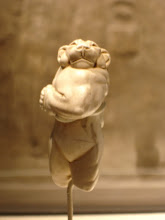Some unexpected free time for a quick post. I did a lightning Internet search and discovered that the Baltic region, and specifically Lithuania, have a tradition of tall, hollowed-out tree stumps carved into the likeness of a grotesque, bearded man and lidded with a thatch roof, with an opening in the mouth through which bees can access a hive within (and a door in the back for the beekeepers to extract the honey). The grotesques honor the bee god Babilas, a Pan-like figure associated with fertility.
There is also a Baltic bee Goddess, Austeja or Austheia. Information on her can be found in the most recent issue of The Beltane Papers (Late Summer 2008 edition, in an article by Goddess historian Patricia Monaghan), at thebeegoddess.com, and in Miriam Dexter Robbins' book The Living Goddesses. The name Austeja appears to blend the word for "weaving" and the word for "flying." (Just an aside: the Sanskrit word "Babila" means "swift." An obscure link between the two bee deities?)
A fascinating beekeeper's museum some 60 kilometers north of Vilnius in Lithuania features a number of Babilas beehives. Open from May to October in Aukstatija National Park, near the town of Ignalina, this museum celebrates an annual Honey Festival in August (which is also the month of Austeja's old feast day). The bee is a symbol of friendship in Lithuanian culture and the term "biciulis," derived from their word for bee, is an affectionate form of address for another person. When bee colonies became over-large and part of a parent hive's population "hived off" to another location, moving from one farm to the next, it established a ritual kinship between the two farm families, "biciulyste" or bee-kinship.
The museum's website is www.muziejai.lt/ignalina/biciu_mus.en.htm
More if I can find it!
Subscribe to:
Post Comments (Atom)

2 comments:
When touring the museum of Basque culture in Bayonne, I was surprised to see bee hives in the funeral display. The description only revealed that it was traditional practice for next-door neighbours to look after funeral arrangements and that the first ones to be notified (after the neighbours, I presume) of a death in the family were the bees. Definitely a sacred connection there.
Absolutely. It's said that the Pharaohs' stripes on their headpieces are a symbol of the stripes of bees. The bee was also worshipped in Minoan Crete and was thought to be born from a dead bull.
Post a Comment